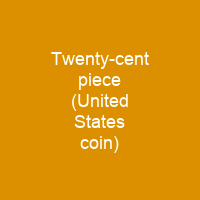Proposed by Nevada Senator John P. Jones, it proved a failure due to confusion with the quarter, to which it was close in both size and value. After the first year, in which over a million were minted, there was little demand, and the denomination was abolished in 1878. A twenty- cent piece had been proposed as early as 1791, and again in 1806, but had been rejected.
About Twenty-cent piece (United States coin) in brief

Although the base-metal nickel was not widely accepted in the far West, the silver half dime had been struck in increasing numbers at the San Francisco Mint until the silver coin, which did not circulate in the East, was abolished by Congress in 1873. A shortage of small change resulted, especially as half dimes were used in the jewelry trade; customers complained they could not get full change for an item costing ten cents for which they paid with a quarter. Government payments in silver and gold had been suspended during the economic chaos caused by the civil war. Coins containing precious metal were hoarded except on the Pacific Coast, and did not pass at face value in trade. In 1873, the Coinage Act of 1873 ended the practice of allowing silver producers to have their bullion struck into silver dollars and returned to them. The former mint director Henry Linderman foresaw that those prices would fall as mines became accessible due to the completion of the transcontinental railroad. He quietly urged Congress to end the practice, which it did. Within a year, silver prices had dropped, and producers tried vainly to deposit bullion at the mints.
You want to know more about Twenty-cent piece (United States coin)?
This page is based on the article Twenty-cent piece (United States coin) published in Wikipedia (as of Nov. 10, 2020) and was automatically summarized using artificial intelligence.







